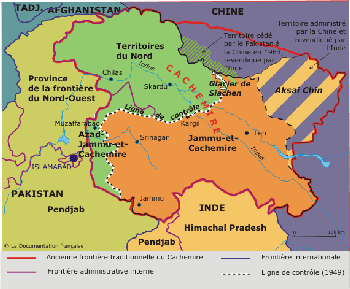Kashmir: A Complex Region
Kashmir will not recover. It is a forgotten region, disputed since 1947 between India and Pakistan. The earthquake that struck it on Saturday has brought it into the spotlight and explains why it might have required this tragedy to possibly bring peace to the Indian subcontinent.
“A whole generation has been lost in the most affected areas. The majority of the casualties are school children,” explained General Shaukat Sultan.
At least 40,000 dead. Cities destroyed like Muzaffarabad, Rawalakot, to name just the most important. Words are no longer enough. A cruel fate. So cruel, too cruel. The planet seems to be punishing its inhabitants but it has chosen to strike the most destitute among us: the Bam earthquake (southeast Iran), December 26, 2003 (26,000 deaths), the tsunami last December (180,000 deaths), and the recent hurricanes Katrina, Rita, and Stan.
40,000 victims of the earthquake. But also 40,000 victims of the war in Kashmir. Why a war? As often happens: an arbitrary division in 1947. The Maharajah of Kashmir decided to join his principality to India so that Indian authorities could help him fight against Pakistani armed forces. Pakistan then occupied 70,000 km² of Kashmir, which is two-thirds of the region it still holds today.
Since then, the tensions have never ceased. It’s a perennial global hotspot, constantly rekindled by state leaders hungry for omnipotence. Arms race. Both countries indeed possess nuclear weapons. Military force deployment at the border of the two countries. And a total refusal from India and Pakistan to make Kashmir autonomous.
1989: an increase in tensions. 1989 is the year the Afghans triumphed over the Soviets. This victory over a superpower gave hope to young Muslim Kashmiri guerrillas. Logistically and financially supported by Islamabad (the capital of Pakistan), they trained in Pakistani camps.
Their goal: to aid the Muslims of the Indian part of Kashmir, who are politically gagged and victims of rigged elections. Though they are the majority, they fail to make themselves heard, feeling oppressed and subdued by New Delhi. This marked the beginning of a civil and religious war. Attacks increased in India. The Indians sealed the border with Pakistan and deployed 200,000 soldiers. Pakistan did the same. Clashes occur regularly.
Since 2001, Pakistan and its president Pervez Musharraf have allied with the United States to fight the Taliban. American diplomacy encouraged Musharraf to do everything possible to ease tensions with India. Following the actions of the Americans closely, the media started to decode the geopolitics of the region. In September 2002, this time free elections were held in Indian Kashmir. A coalition composed of a party opposed to the Indian government and a popular Kashmiri party was established. However, the border remains completely blocked even though a bus line was opened in February 2004 between the “two Kashmirs.”
The tragedy on Saturday brought India and Pakistan closer. The military from both countries collaborated on the ground to help the inhabitants. Many soldiers stationed at the border perished. United in grief, united in assistance. Starting on Saturday, President Pervez Musharraf communicated with Indian Prime Minister Manmohan Singh. Both countries requested international aid. A renewed dialogue and an international presence are the best recipe to bring peace to Kashmir. Let’s hope so. The people of Kashmir deserve to live in peace, to envision a happier future, and to forget this apocalyptic present.
Vincent Trinquat
Feel free to inform the editorial team of solidarity movements set up on the French Riviera.
Map provided by the French Documentation Center. You can find more information on their website: [French Documentation Center](https://www.ladocumentationfrancaise.fr/dossiers/inde-pakistan/index.shtml)


